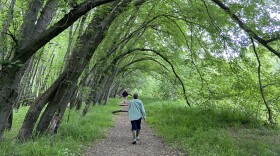If you wander along the Merrimack River, not far from downtown Concord, you find yourself in a rare and special riverside environment: a silver maple floodplain forest. Most of the trees in this area are the same species, with arching trunks over an open understory. The forest has remained virtually unchanged despite centuries of agricultural and industrial growth along the river.
Specialized plant communities take advantage of the rich, silty soil deposited by annual flooding cycles. And of course, the silver maple floodplain is valuable to tons of wildlife, including birds and turtles.
Our indigenous predecessors would probably not recognize most of the contemporary forests in New Hampshire. But they’d certainly recognize the sturdy trunks of silver maples and the overarching canopy at the river's edge. These maples lined all the primary pre-colonial transportation corridors, when rivers like the Merrimack, Connecticut and Saco were analogous to modern highways.
Before agricultural and industrial development, silver maples won by default, being best adapted to shifting sand and silt. They are able to tolerate late winter and early spring flooding, as well as periodic ice jams along the major rivers.
Bird migration often follows river floodplain corridors, thanks to early green-up in the spring, and then fruit and berry production in the fall. Floodplain birds include bank swallows, eastern king birds and belted kingfishers.

Eagles, barred owls, and red-shouldered hawks often nest near floodplain wetlands, and waterfowl and wading birds like ducks, herons, and sandpipers stalk fish and amphibians.
Wet meadows, thickets, shrubs, and silver maple forests around oxbow ponds, formed by the river channels, are the original fast food “Miracle Mile.” It's where insects feed fish and amphibians, which feed birds and small mammals, which, in turn, feed larger predators and birds of prey.
In Concord, silver maple floodplain forests grow along the fringe of the river's edge. Further south, industrial development transformed the banks of the river. Imagine what this area looked like 500 years ago; in addition to silver maples, you would also have seen extensive riverside forests of sycamore, cottonwood, green ash, and American elm, from Franklin to the mouth of the Merrimack.
One of the best ways to experience a floodplain forest is to hike along the major rivers, such as the Merrimack, Connecticut or Saco rivers. Or pick up a paddle, put your canoe in the water and see it from the river side!

Something Wild is a partnership of New Hampshire Audubon, the Forest Society and NHPR, and is produced by the team at Outside/In.











